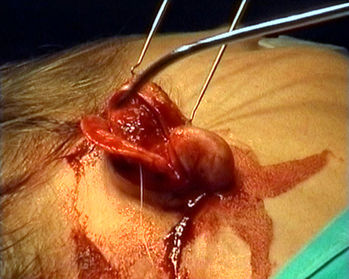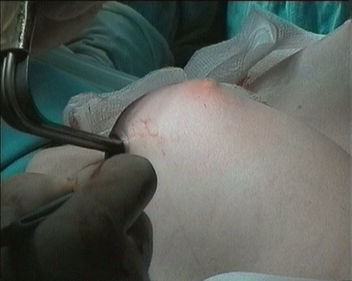LEORA FARBER
FOUR MINOR RENOVATIONS
REVAMP, REFURBISH, RETOUCH, REFINE

There's nothing wrong with the instrument,
its the body, the body is all wrong
Dead Ringers, directed by David Cronenberg, 1988
Video artwork on dvd: 28: 50 looped, 2000
Exhibited on Endless Renovations (2000), Joao Ferreria Fine Art, Cape Town; Surface, Substance and Design (2002), curated by Ellen Lupton, Cooper-Hewitt Design Museum, Smithsonian Institution, New York City (catalogue); Second Skin (2007), curated by Ellen Lupton, Museum of Contemporary Art, Taipei, the Kaohsiung Museum of Fine Arts, Taipei (catalogue) and All You Can Be (2001), Snowflake building, Potchefstroom (catalogue).
In works from 1999-2001, I focus on the relationship between the female body and contemporary biotechnologies. With this conceptual shift, I consciously change from using physical, tactile materials to the lens- and technologically- based media of photography and video. Four Minor Renovations shows edited footage of 4 cosmetic surgery procedures: an otoplasty (bat-ear pin back); a rhinoplasty (nose-job); a blepharoplasty (eye-lift) and a hytidectomy (face-lift). Tightly cropped and set in slow motion to a slowed down score of Beethoven's piano concertos, a pair of disembodied, gloved hands repetitively cut into, peel back, stretch, excise and stitch up flesh. While the meticulous precision of 'fashioning' malleable flesh and harmonious music evoke a soothing, almost meditative sense of serenity, this is simultaneously undercut by the shockingly graphic, visceral nature of the imagery.
In the editing process, I highlight the surgeon’s role in modifying the body intending of setting up an analogy between the (male) surgeon and sculptor who moulds and shapes ‘formless matter’ to create ‘the perfect female form’. Paralleling my earlier preoccupation with the ‘craft’ of tailoring a garment to fit a particular body size, the surgeon’s ‘art’ of body-modification is an actual means of fabricating external appearances. The surgeon’s actions mimic garment-making techniques: the ideal pattern is marked out on the skin in dotted lines, the skin is cut, excess is removed and the loose pieces are re-joined with sutures. Again, skin is the site and marker of control; a fabric that can be altered, tucked, pricked or manipulated to conform to, and comply with, cultural and ideological standards based on western markers of beauty. Thus, rather than a re-creation of identity, arguably, it is westernised ideological gendered constructs that are realised as the surgeon’s scalpel enacts the process of remaking difference into sameness.

















